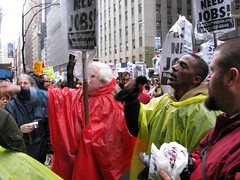
Demonstration organized by the Bail Out the People Movement (BOPM) outside Bank of America on April 3, 2009 in New York City. (Photo: Alan Pollock)
Originally uploaded by Pan-African News Wire File Photos
Economic Decline in Quarter Exceeds Forecast
By LOUIS UCHITELLE and EDMUND L. ANDREWS
New York Times
The American economy is contracting at its steepest pace in 50 years, the government reported Wednesday, but an unanticipated rise in consumer spending since January suggested to many economists that the worst of the recession might have passed.
The last six months were brutal. Output fell at a 6.1 percent annual rate in the January-through-March quarter after falling at a rate of 6.3 percent in last year’s fourth quarter, according to the Commerce Department. If that pace were to continue, nearly $1 trillion would be wiped out this year from the nation’s economic output of $14.2 trillion last year.
Not since 1958, in the wake of a brief but severe collapse in home construction, has the national economy lost so much ground in just six months. But as tax breaks and government stimulus spending kick in, the decline in the gross domestic product could be cut in half by summer.
“The situation is not nearly as dark as the first-quarter number suggests,” said Mark Zandi, chief economist at Moody’s Economy.com, echoing the opinion of many forecasters, who see the contraction continuing, but at a slower rate until growth returns late this year or in early 2010.
Stock prices rose, partly in response to this prospect. The Dow Jones industrial average was up 168.78 points, or 2.11 percent, closing at 8,185.73.
The looming question remains the severity of job losses. More than five million jobs have disappeared since the recession began in December 2007. As their wages disappear, households spend less, and business, in response, reduces the output of goods and services, cutting more jobs in the process.
That dog-chasing-its-tail cycle was evident in the latest G.D.P. report, except for consumer spending, which rose at its best pace since the recession began. A sharp drop in fuel prices, economists said, helped to free up money for other spending.
“The biggest wild card going forward is whether that spending can hold up,” said Brian A. Bethune, an economist at IHS Global Insight.
The Federal Reserve’s policy makers, echoing the incipient optimism, said in a statement issued Wednesday, at the end of a two-day meeting, that the outlook had “improved modestly” and that the Fed would continue to pump tens of billions of dollars into the economy to keep credit flowing. To encourage this borrowing, and spending, interest rates controlled by the Fed would remain near zero, the policy makers said.
In a rare public forecast, Paul A. Volcker, a former Fed chairman and now an economic adviser to President Obama, added his voice to the optimism, although cautiously. “I’m not here to tell you the economy is going to recover very strongly in the short run,” Mr. Volcker said in an interview recorded for a weekend show on Bloomberg Television. But he said the improvement was sufficient to avoid a second government stimulus on top of the $787 billion in spending and tax breaks enacted in February.
An obstacle to easier credit, however, might come from the Treasury Department, which said in a report issued Wednesday that it would step up the issuing of 30-year bonds. The funding is needed to help finance the hundreds of billions of dollars that the government is spending on bank bailouts and stimulus. But the quickening pace could force Treasury to raise long-term interest rates to attract enough buyers for the bonds — an action that in turn could impede lending.
A special advisory committee to the Treasury warned in a report that the government’s huge and rapidly escalating need to borrow money would weigh heavily on the financial markets and that investors would demand higher interest rates in exchange for buying up the avalanche of new bonds.
Until now, that has not been a problem, the report said. Investors have snapped up Treasury bonds as a haven for their money in a troubled world economy, and China invested the proceeds of a huge trade surplus in United States government securities.
“Treasuries will probably not receive the same favorable demand treatment from either source over the coming quarters,” the advisory committee’s report said.
Consumer spending stood out as the only significant bright spot in the Commerce Department’s otherwise bleak update on the gross domestic product, the broadest measure of the nation’s economic activity, which has now posted three straight quarters of decline. Consumer spending turned up in the first quarter, rising at a 2.2 percent annual rate, for the first time since last summer.
Most of the spending was on autos, kitchen appliances, computers and other durable goods. But retailers allowed shoppers to draw down inventories, without reordering to fill their shelves. Indeed, imports, a source of much of the nation’s consumption, fell sharply, along with exports. And so did business investment.
Adding to the damage, government spending at the state and local level either declined or fell sharply. That presumably will reverse in the current quarter, as the $787 billion stimulus package kicks in this spring. Indeed, many economists are counting on the federal spending and on various small windfalls for consumers to ease the recession in the months ahead.
The Social Security Administration, for example, is sending $250 checks in early May to each of the millions of older people getting benefits. And thousands of employers, responding to new federal rules, are cutting the amounts withheld from their employees’ weekly and monthly pay checks — in the process fattening take-home pay.
“These fiscal policy measures will play a key role,” said Robert J. Barbera, chief economist at ITG Investment Technology Group, “in gradually lifting economic growth.”
Jack Healy contributed reporting.
No comments:
Post a Comment